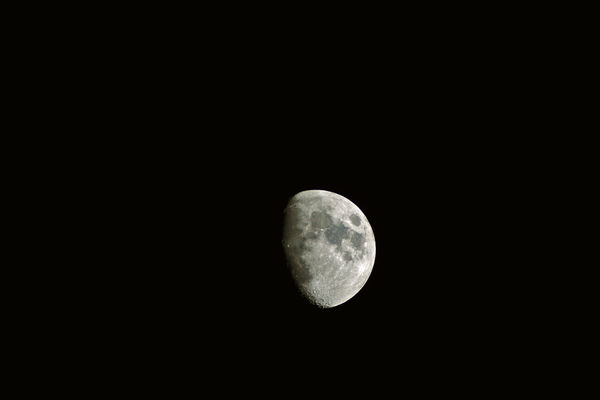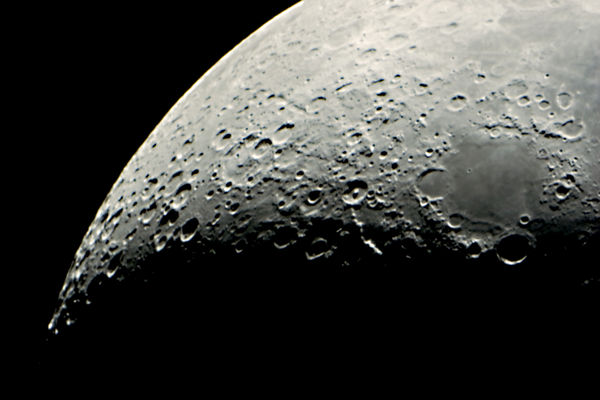Telescope for moon photos
Nov 6, 2013 00:47:06 #
What magnification on a telescope will produce a decent size image of the moon? I know nothing about telescopes and I have watched a few youtube videos but they are in reference to star patterns, constellations, etc. I want large images of the moon. I have a 70-300mm Nikkor lens for my DSLR but the images are still small. How can I find out about magnification of telescope? Thanks for your input.
Nov 6, 2013 00:50:46 #
This thread was moved to this forum, where your question will be seen by members with similar interests.
Astronomical Photography Forum
http://www.uglyhedgehog.com/s-109-1.html
To place the Astro Forum on your UHH home page, you must subscribe here:
http://www.uglyhedgehog.com/section_list.jsp
Astronomical Photography Forum
http://www.uglyhedgehog.com/s-109-1.html
To place the Astro Forum on your UHH home page, you must subscribe here:
http://www.uglyhedgehog.com/section_list.jsp
Nov 6, 2013 05:35:41 #
A telescope is a lens if your camera is connected as the eye piece. The size of the subject (moon) is determined by the size of the print. If you crop the image the quality will be determined by the aperture of the telescope and the pixels or the camera sensor.
Nov 6, 2013 05:46:22 #
profpb wrote:
Is your telescope still for sale?: http://www.uglyhedgehog.com/t-112655-1.htmlA telescope is a lens if your camera is connected as the eye piece.
Do you have Astro-Photographs that you captured, either with your telescope, or any telescope?
Nov 6, 2013 12:54:43 #
With my 1500mm focal length telescope at prime focus (telescope+camera, no eyepiece), the moon covers the short length of my frame (crop sensor Canon T3i).
http://lordmajestros.deviantart.com/art/Full-Moon-Redux-401197631
If you do eyepiece projection, then the combination of the eyepiece focal length and the telescope focal length will determine your magnification. So basically you could use any telescope if you had the right eyepiece with EP projection.
I would say that most people prefer prime focus astrophotography but I can't really be sure on that.
Additionally, since the moon is so bright, you can basically use a telescope with any aperture, but obviously, more expensive telescopes and mounts will yield higher quality images.
http://lordmajestros.deviantart.com/art/Full-Moon-Redux-401197631
If you do eyepiece projection, then the combination of the eyepiece focal length and the telescope focal length will determine your magnification. So basically you could use any telescope if you had the right eyepiece with EP projection.
I would say that most people prefer prime focus astrophotography but I can't really be sure on that.
Additionally, since the moon is so bright, you can basically use a telescope with any aperture, but obviously, more expensive telescopes and mounts will yield higher quality images.
Nov 6, 2013 23:08:14 #
I wanted to add that you need to make sure the telescope can achieve prime focus if you decide to go that route. Most refractors and catadioptric scopes can, but many Newtonian reflectors cannot. Just inquire if your scope can reach prime focus before you buy if you go that route.
Nov 7, 2013 10:19:07 #
Magnification in a telescope comes from the eyepiece, not the telescope itself.
Below are two photos of the moon that I took back in 2006 with my Canon 20d (cropped sensor). Neither image is cropped.
The first is from my Williams Optics 4" refractor with a focal length of 480mm. Great scope to travel with. I went to Egypt in 2006 for the total eclipse and used this scope. (even found a photo of me using my scope on the pages of the Al Jazzeera website)
The second shot is taken from a Celestron 14" cassagrain telescope, which has a focal length of 3910mm. Can't get the whole moon in one shot with that scope.
Hope this gives you an idea of what different focal lengths look like.
Below are two photos of the moon that I took back in 2006 with my Canon 20d (cropped sensor). Neither image is cropped.
The first is from my Williams Optics 4" refractor with a focal length of 480mm. Great scope to travel with. I went to Egypt in 2006 for the total eclipse and used this scope. (even found a photo of me using my scope on the pages of the Al Jazzeera website)
The second shot is taken from a Celestron 14" cassagrain telescope, which has a focal length of 3910mm. Can't get the whole moon in one shot with that scope.
Hope this gives you an idea of what different focal lengths look like.


Nov 29, 2013 10:58:50 #
JoelS wrote:
What magnification on a telescope will produce a decent size image of the moon? I know nothing about telescopes and I have watched a few youtube videos but they are in reference to star patterns, constellations, etc. I want large images of the moon. I have a 70-300mm Nikkor lens for my DSLR but the images are still small. How can I find out about magnification of telescope? Thanks for your input.
Magnification of a telescope is determined by what eyepiece you use. To determine approximately what size the moon's image will be on your photographs you can use the following:
FOV=(3439.d)/F
FOV is the Field of View
3439 is a constant number
d is the size of the chip in your camera. An APS-C chip is typically 14.9mmx22.3mm. You will have to run the equation twice to get the size of the FOV, one for 14.9 and again for 22.3
F is the focal length in mm of the telescope or lens that you are using.
Using a 500mm lens and a camera with an APS-C chip. we get 102.4822. This is in minutes of arc on the 14.9mm side, to get the 22.3mm side simply run the equation again substituting 22.3 for 14.9. To convert to degrees we simply divide that number by 60.
Using this simple equation we find that a 500mm lens will produce a Field of View of 1.7x2.6 degrees.
The moon has an apparent diameter of 0.5 degrees, so the image of the moon will be about 1/3 the size of the FOV as seen from top to bottom of the frame. See the above image taken by jkay65 with his 480mm telescope. As one can see the moon in his frame is about 1/3 the size of the frame.
Using a telescope (Meade 12-inch f/10) at prime focus (120 inches=3048mm) yeilds an image scale of 16.8' x 25.2' of arc. The moon's apparent diameter is approximately 30' of arc (the ' sign above the numbers is the mnute of arc sign). As one can see the moon's disk will not quite fit into an APS-C frame fouund on todays cameras. You will have to make a mosaic to get the full image of the moon.
This formula works with all lenses and telescopes. I hope this helps in your selection of an instrument.
If you want to reply, then register here. Registration is free and your account is created instantly, so you can post right away.





